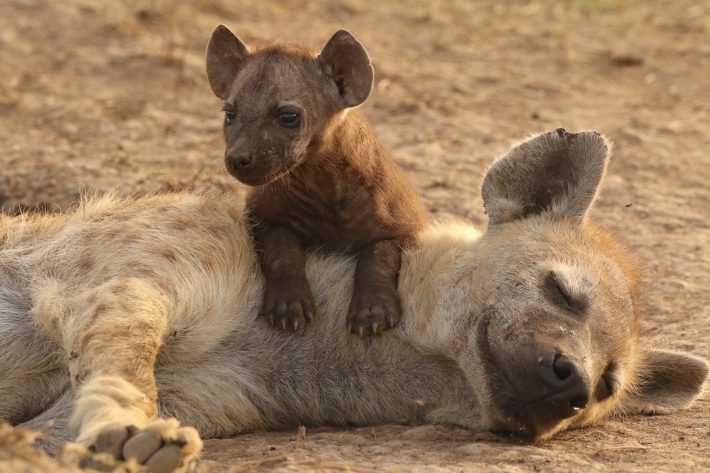Spotted Hyena lifespan and reproductive success is impacted by formative conditions
Leibniz Institute for Zoo and Wildlife Research press release.
Maternal, social and ecological factors influence early-life survival, longevity and reproductive performance of female adult spotted hyenas finds new research by the Leibniz Institute for Zoo and Wildlife Research published in the British Ecological Society Journal of Animal Ecology.

Scientific analyses indicate that in humans several factors such as traumatic experiences during childhood have long-term effects on health and life expectancy.
A team from the Leibniz Institute for Zoo and Wildlife Research (Leibniz-IZW) has now demonstrated the important influence of maternal, social and ecological factors during early life on survival, longevity and reproductive performance of female adult spotted hyenas: For example, the social status of the mother had a significant, positive effect on the reproduction of the following generation. On the other hand, being born to an elder mother or growing up during a period of increased rainfall reduced survival and longevity.
The authors suggest in their paper, published in the British Ecological Society Journal of Animal Ecology, that the combination of specific conditions during early life may matter more than the simple accumulation of either beneficial or adverse conditions to predict life prospects in wildlife populations.
In a long-term investigation, the scientists from Leibniz-IZW analysed data from the life histories of 666 female spotted hyenas (Crocuta crocuta) which they studied in the Serengeti National Park in Tanzania from 1987 to 2020. They investigated how certain maternal, social, demographic and ecological factors affect their evolutionary fitness.
Offspring of elder mothers have a significantly shorter lifespan and raise fewer young
The researchers not only determined the effects of individual factors on evolutionary fitness but also investigated how the different combinations of circumstances during early life affected life histories and whether several adverse early life conditions have a simple cumulative effect. To measure performance and evolutionary fitness researchers recorded how many of an individual’s offspring reached reproductive age and thus could pass on their genes to the next generation. Early growth rate, survival to adulthood, age at first reproduction, longevity and lifetime reproductive success were all analysed.
“Through careful analyses of the long-term data we were able to show clearly, for example, that female offspring of elder mothers have a significantly shorter lifespan and raise fewer young than those of mothers in their prime age,” says Morgane Gicquel from the Leibniz-IZW, the lead author of the paper that is a part of her dissertation.
Social status, litter size and offspring dominance status only mattered to hyena offspring in the first few years
Daughters benefited if their mother had a high social status as it allowed the daughters to reproduce at a younger age. Singletons and dominant cubs in twin litters had a higher growth rate than subordinate cubs in twin litters. Offspring without siblings also had a higher chance of survival to adulthood than subordinate cubs in twins.
“We were surprised to find that maternal social status, litter size and offspring dominance status only mattered to hyena offspring in the first few years, namely for survival to adulthood and for age at first reproduction, but that they did not influence longevity or lifetime reproductive success,” adds Gicquel.
Dr Sarah Benhaiem from Leibniz-IZW, senior author of the paper adds: “In contrast, we found both short-term and long-term effects for the number of lactating adult females in a clan”
Heavy rainfall in the first six months of life reduced the chances of young spotted hyenas surviving to adulthood
“As the number of lactating female clan members increased, growth rate, survival to adulthood and lifetime reproductive success of the offspring decreased. This could be related to more frequent conflicts and increased competition among breeding females.”
Dr Marion East from Leibniz-IZW, co-founder of the Serengeti Hyena Project and co-author of the paper explains: It is not only maternal, social and demographic factors that play a role but also ecological ones. “For instance, heavy rainfall in the first six months of life reduced the chances of young spotted hyenas surviving to adulthood, possibly owing to increased parasite loads and transmission of pathogens or the flooding of communal dens, leading to cubs drowning,”
Co-author, co-founder of the project and Leibniz-IZW director Prof Heribert Hofer adds: “In terms of climate change, it now rains more in the Serengeti than ever before – quite in contrast to many other areas in Africa. In the light of these insights, this might have a long-term negative effect on the population. “
The analyses also showed that specific combinations of maternal, social, demographic and ecological factors experienced during early life by Serengeti spotted hyenas predicted individual life histories and lifetime performance much better than the simple sum of adverse conditions. This suggests that it may not be enough to count the number of adverse conditions – their specific quality may be more important, at least in wildlife species.
You can access the full research article here:
https://besjournals.onlinelibrary.wiley.com/doi/10.1111/1365-2656.13785
Like what we stand for?
Support our mission and help develop the next generation of ecologists by donating to the British Ecological Society.